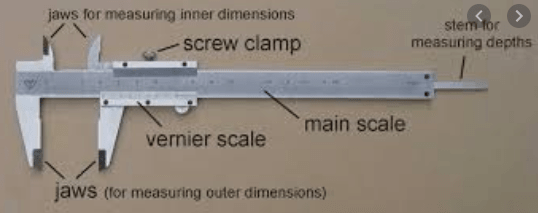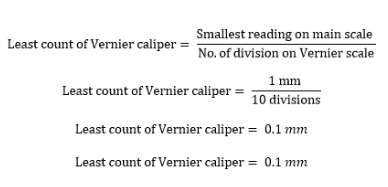What is the Least count of Vernier caliper?
The Vernier caliper least counts formula is calculated by dividing the smallest reading of the main scale by the total number of divisions of the Vernier scale. Least count of the vernier caliper is the difference between the smallest reading of the main scale and the smallest reading of the vernier scale which is 0.1 mm 0r 0.01 cm.
Vernier caliper is an instrument used to measure the length, diameter, radius, etc. It can measure up to 1/10 of mm (or 0.1 mm 0.01 cm) which is called vernier caliper least count. It is used by the lathe mechanic for making metallic cylinders of different sizes.
There are two scales of V.C
- Vernier scale
- Main scale
The main scale is graduated in centimeters while the Vernier scale slides along the main scale and is graduated in division (less than the millimeter).
Parts and function of vernier caliper

There are two sets of jaws:
- Two jaws
- Main scale
- vernier scale
(1) Lower Jaws:
The lower jaws A and B are used to measure length. The thickness or external diameter of an object.
(2)Upper Jaws:
The upper jaws C and D are used to measure the internal diameter of objects like a hollow cylinder or tube.
The jaws A and B are fixed whereas B and D are movable. The movable jaws are attached to the vernier and they slide along the main scale.
Read also: Micrometer screw gauge
Vernier caliper least count formula
The smallest reading which can be accurately measured with a vernier caliper is called its least count (L.C), it is also known as the vernier constant. It is the difference between one main scale division which is 1 mm and one vernier division which is (0.9).
L.C = 1 mm – 0.9 mm =0.1 mm
There is another method to find the least count which is given as:

Vernier caliper zero error
When the jaws of Vernier calipers are brought into contact, the zero of the Vernier must coincide with the zero of the main scale. Otherwise, the instrument has an error called zero error. Zero error can be negative or positive.
Negative Zero Error
If the zero of the Vernier scale is to the left of the zero of the main scale then the error is negative. Since the zero error is negative, the zero correction will be positive.
Positive zero error
If the zero of the Vernier scale is to the right of the zero of the main scale then the error is positive. Since the zero error is positive, the zero correction will be negative.
Read also: Types of errors in physics
How to find least count of vernier caliper?
We can learn about the use of V.C with the help of an example by measuring the area of the cross-section of a solid cylinder by measuring its diameter with a Vernier caliper. We will solve this example step by step.
- Find the least count. Close the jaws to check the Zero error and calculate the zero correction.
- Hold the cylinder between the two jaws of the vernier caliper. Tighten the jaws gently.
- Note the main scale division which is either coinciding or is on the left of the vernier scale zero.
- Record this value as the main scale reading (M).
- Note the vernier division (n) which exactly coincides with any one division of the main scale.
- Multiply this “n” with the least count and calculate the value of fraction (x) which is to be added to the main scale reading.
X = ( n × LC )
- Add the values ‘M ‘ and ‘X ‘ to the observed value (Y) of diameter.
Y = M + X
- Apply zero correction to obtain the correct diameter. (D)
D = Y ± Z C
- Take at least two readings by inserting the cylinder cross-section-wise between the jaws and get the average diameter.
- Calculate the radius of the cylinder
vernier caliper Calculation
Least count (LC) = 0.1 mm = 0.01 cm
Suppose zero error is = 0.7 cm which is a positive error so:
Zero correction ( ZC ) = -0.07 cm
| No of Obs | Main scale reading M (cm) | No of vernier divisions coinciding with the main scale divisions ( n) | Fraction to be added X=n × LC (cm) | Observed diameter Y =M+X (cm) | Corrected diameter D=Y ± ZC (cm) |
| 1 | 2.2 cm | 6 | 6 × 0.01=0.06 cm | 2.2 + 0.06=2.26 cm | 2.26 -0.07=2.19 cm |
| 2 | 2.3 cm | 6 | 6 × 0.01=0.06 cm | 2.3+0.06=2.36 cm | 2.36 -0.07=2.29 cm |
| 3 | 2.4 cm | 6 | 6 ×0.01=0.06 cm | 2.4+0.06=2.46 cm | 2.46 -0.07=2.39 cm |
Mean diameter (D) = 2.29 cm
Radius of the cylinder (r ) = D/2 = 2.29 /2 = 1.145 cm
Area of the cross-section of solid cylinder = π r²
=3.14 (1.145)² cm²
The area of the cross-section of the solid cylinder will be =4.11 cm²
Cautions about use of V caliper
- The jaws of V C should be closed gently
- Zero correction should be applied
- Both jaws should touch the cylinder
Uses of vernier caliper
- It is used to find diameter internally and also externally.
- Plumbers, aluminum and steel window makers also use it.
Watch also video
Related posts:
You have explained about vernier calipers very well. All information is accurate…thanks
Very nice information..includes everything taking into account positive and negative error analysis and correction really very useful ….Thanks a lot……
thanks..
This helped me a lot..thanks for the information